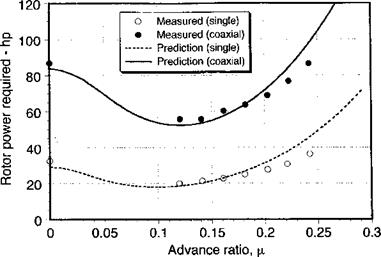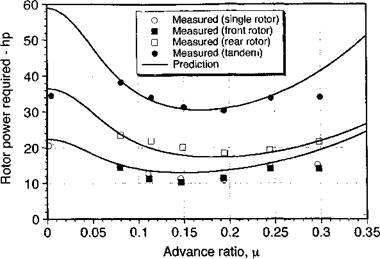Performance of Coaxial and Tandem Dual Rotor Systems
The hovering performance of coaxial and tandem rotors has been previously discussed in Section 2.15.1. By accounting for the induced interference effects between the rotors, it has been shown that the relationship between power and thrust can be adequately
|
Figure 5.22 Predictions of power in forward flight for single and coaxial rotor system compared to measurements. Data source: Dingeldein (1954). |
estimated using a variation of the simple momentum theory. The power required for a coaxial rotor system operating in forward flight at a constant thrust coefficient and over a range of advance ratios is shown in Fig. 5.22. The experimental data are taken from Dingeldein (1954). The predictions were made using the extension of simple momentum
4-і____ ——————- 1 апллл,»«^ fVx*.
шсшу iu luiwaiu infill, wiiu uic сіюсіь ui jnuiuc; lusdoa a^^uumtu ivn uuuugu tut/ uiau^
element theory, in the same manner used previously for the single rotor. The single rotor had a solidity of 0.027 and the coaxial rotor had a solidity of 0.054. An equivalent flat-plate parasitic drag area of 10 ft2 was used to define the propulsive force component, along with Cdg = 0.01, к — 1.15, and кт = 1.16, the latter being derived from the hover case and assumed to be valid also for forward flight.
For both the single and coaxial rotors, the predictions in Fig. 5.22 compare favorably with the measurements, although there is a slight over prediction of power at the highest advance ratios. It is clear that for the coaxial configuration, there is a higher overall power requirement than for an equivalent single rotor. This is because of the interference effects between the two rotors. Also, the higher overall parasitic drag of the two hubs and dual control linkages (see Fig. 4.13) make a coaxial rotor aerodynamically less efficient than a single rotor system. However, this negative aspect can be outweighed by the overall reduced rotor size and compactness of the coaxial rotor helicopter design.
The forward flight performance obtained with a tandem rotor configuration is shown in
Iji/y С О О лі/чмґ» г» Wranb-rl/Mim tU а плигл«* **л/пп 1 na/I nannrnfalTi Frvr fVta frnnt on/1 root*
1 ig. aiuug wlLii <x uiV/Oivuuwїї иі uiu puwui luvjuiiuu oupmaiuij iui uiu num aiiu іиш rotors. There is no rotor overlap for this particular tandem configuration, with the rotor shafts being separated by 103% of the rotor diameter. Each rotor had a solidity of 0.027. The equivalent flat-plate area drag was 2 ft2. Note that the performance of the front rotor was almost identical to that of the single rotor, suggesting that in this case there is little or no interference produced on the forward rotor by the rear rotor during forward flight. This, however, may not be a general result that is independent of rotor spacing or relative difference in rotor height. Prediction of performance by means of the momentum/blade element theory is, therefore, of the quality expected based on previous studies with single rotors. The power
|
Figure 5.23 Predictions of power in forward flight for a tandem rotor system compared to measurements. Data source: Dingeldein (1954). |
required for the rear rotor is considerably higher because it operates in the downwash generated by the front rotor[20] – see Heyson (1954). By computing the downwash from the front rotor, this can be used to redefine the flow environment encountered by the rear rotor. The induced power for the combination becomes
Pi = TFvif +KmTRviR, (5.81)
where TF and Tr are the thrusts of the front and rear rotor, respectively. An induced power interference factor, /cov, equal to 1.14 (see Section 2.15.2) was assumed for the rear rotor, for which the power required can then be estimated. For advance ratios of 0.1 and above, Fig. 5.23 shows that there is a good agreement between the predictions and the measurements. Note that because of the effects of the forward rotor, the minimum power required for the rear rotor is attained at a much higher advance ratio. Combining the results for the two rotors gives the power required for the tandem configuration. Agreement between prediction and experiment is generally good, except for low advance ratios approaching hover where the experimental results show a favorable interference effect. Based on the results shown previously in Section 5.5.11, this favorable effect seems unique to this tandem configuration and would not necessarily be expected for substantially overlapping tandem rotors.













